 |
"An American in Paris" makes sense – all us crude Yankees crave a touch
of European class. But a Frenchman in Detroit? Why would an emissary of the world’s
most refined culture come to Motown?
Throughout its history, classical music developed in distinct national schools. While
European artists occasionally would entrain for Russia or set sail for the New World, most
were content to remain nestled in their own culture. Recently, though, that all changed. classical music developed in distinct national schools. While
European artists occasionally would entrain for Russia or set sail for the New World, most
were content to remain nestled in their own culture. Recently, though, that all changed.
Blame America as the catalyst. At first, we were the poor stepchild, with no distinct
heritage of our own. But as repression and then genocide pushed European artists to
emigrate to fill the vacuum among our wealthy but unenlightened masses, something new
emerged – a multicultural force that blended together into a pluralism that gleamed
brighter than any of its components. Innovations in transportation and technology promise
to accelerate the process: modern soloists already can jet to European, Asian and American
concert halls in a single week and soon virtual performances may supplant the need to
appear in person at all.
But while much was gained in harmonizing discrete traditions to meet the demands of a
modern, unified world, something important was lost. While a century ago the latest works
were eagerly anticipated and showered with attention, nowadays classical music focuses
exclusively on the repertoire of the past. All of the music we admire was written decades,
if not centuries, ago by composers raised in a specific tradition. Take Bach away from his
Lutheran church, deprive Wagner of his German mythology, extract Tchaikovsky from his
Slavic roots, and they never would have produced the works for which we now revere them.
These same composers all expected their music to be performed by artists immersed in
those same traditions. While an American generalist like Bernstein could produce credible
readings of nearly anything, there’s something uniquely satisfying in hearing
Mravinsky conduct Russian symphonies, Furtwangler lead German music, Beecham conjure the
British, or the old La Scala sets of Italian operas. Their recordings have served (and
will continue to serve) a crucial role in preserving the authentic sound of these distinct
national traditions which have largely disappeared but which represent the way our
favorite composers wanted their work to be played. All these records serve as crucial
models for modern and future authentic performances.
And what about the French? Hey – want to be a millionaire? Multiple choice: The
greatest French orchestra on record is in (A) Paris, (B) Marseilles, (C) Lyons, or (D)
Detroit? 50/50? OK, let’s eliminate (B) and (C), so it's between Paris and Detroit. Final answer? Are you sure? Well,
I’ll bet you were wrong – the correct answer is D. That’s right – the
very essence of refined French culture is in the Motor City, or at least it was from 1952
to 1963. That’s when the Detroit Symphony Orchestra (the "DSO") led by Paul
Paray recorded a legendary series of LPs with Mercury’s "Living Presence"
label.
Paray was born into a musical family in 1886. Despite the interruptions of both World
Wars (he spent most of the first as a prisoner of war and the second with the Resistance)
he established a solid reputation as a French conductor, heading orchestras in Lamoureux,
Monte Carlo and Paris. American guest stints led to his appointment as permanent conductor
of the recently reorganized DSO. Their very first records prove that he quickly forged the
ensemble into a truly great orchestra and transformed its sound into a replica of those he
had known in France. (Paray ultimately parted ways with the DSO in 1963 but remained
active well into his ‘nineties; conductors do tend to last a very long time!)
It’s especially remarkable that the fiercely proud French tradition should thrive
in the heart of America, the very place where national trends became forsaken and
assimilated. After all, French culture is the most deeply chauvinistic of any, proudly
defended to the death against the pollution of foreign influence. Indeed, the most famous
French music has a unique sound, often described as impressionistic, much like the
paintings of Monet and Renoir. It’s a valid analogy. Like that art, French
impressionist music is concerned more with color effects than formal structure, as sensual
melodies briefly appear before flitting away. While the overall effect is of subtle,
blended mist, the sound is achieved through a layering of distinct instruments, much as in
a Seraut painting in which the pastel atmosphere arises from dots of intense color.
That’s what Paray gives us – not a sonic blur but precise dabs of bold
instrumental coloration. Just as brushstrokes are carefully placed, the DSO’s rhythm
and articulation of individual notes are always precise and luminously clear.
The analogy even extends to the recordings. In early 1953, Paray and the DSO cut their
first records for Mercury, which had startled the hi-fi world in 1951 with the
unprecedented clarity and musicality of an acclaimed series of albums using a single
microphone and no equalization, filtering, mixing or compression. The elegance of this
approach was continued in late 1955 with multi-channel recordings using only three mikes,
each separately tracked on half-inch tape (later 35 mm film) and then mixed down to
stereo. The result is not only astonishingly vivid (eclipsing many recent DDD CDs) , but
manages to project a soundstage image that gives a wonderful sense of the atmosphere of
the recording venues which were chosen for their distinctive acoustics. Just as you can
glean detail from an impressionist painting by looking closely at the canvas,
Mercury’s sound provides aural glasses that let you approach and appreciate the
quality of Paray’s intricately woven sonic fabric.
As a further touch of integrity, CD conversions were made with the original tubed
equipment and were supervised by Wilma Cozart Fine, the original recording director. (Her
husband Robert had been the chief recording engineer.) So far, all of Paray’s stereo
records with the DSO have emerged on CD except the Beethoven Symphonies 1 and 2 and
the Mozart "Haffner" Symphony; they’d fit well on a single disc
(hint!). Of their dozen mono LPs, only the Schumann Symphony # 4 is available;
let’s hope for the others, including Rimsky-Korsakoff’s Capriccio Espagnol,
"Antar" Symphony and Russian Easter Overture, Beethoven’s Symphonies
6 and 7, Brahms’s Symphony # 4, Liszt’s Les Preludes, Faure’s
Pelleas et Melisande and Roussel’s Spider’s Feast.
Naturally, Paray brought an appropriate Gallic touch to the great French repertoire.
His Debussy, Ravel, Chabrier and Roussel are magnificent, beautifully capturing their
elegance with a self-effacing confidence. The DSO complements Paray’s approach with
superb playing, each instrument gleaming with individual pride yet prefectly nestled in
the ensemble. Paray also produced unusually polished and convincing readings of overtures
and light pieces, according them a respect usually reserved for more challenging music.
Equally fascinating is Paray’s touch applied to music of other national schools.
Especially revealing are the symphonies of Saint-Saens, Franck and Berlioz. Although all
three composers were French, their symphonies, a traditional German form, are cast in
seething Teutonic mysticism and are usually played with dark, heavy drama. Paray, though,
lightens the textures and emphasizes the interplay of instruments. He works similar
wonders with Rachmaninov, Sibelius and even Wagner, the epitome of German music and about
as far from the French aesthetic as possible.
Paray brought to all his work the highest achievement in any art, whether acting,
painting or music – from careful preparation, constant revision and grueling work
emerges something natural, accessible and inviting. And through this process, Paray
created and preserved an island of his native land in a most unlikely place, as distant
geographically and culturally as could be. His DSO records prove his undeniable success.
So vive Paray, Motown and its fabulous orchestra!
- - - - - - -
The reissue on CD of Paray’s Mercury Living Presence records began nearly a decade ago, and all volumes seem to still be in print and available.
Except where I’ve noted, the orchestral playing is consistently superb, as are most
of the recordings (the exceptions being the first stereos (December 1955) which lack
top-end finish, and, curiously, his last ones (1961-2), which tend toward overload. To
help track the chronology, I’ve added the recording dates given on the CDs for each
of the selections, as well as the year in which the CD was issued. A welcome bonus is
generally fine liner notes.
Just to be a bit perverse, I’ll start with the works with which one would assume
Paray to be the least attuned and work up to those in which he fulfils expectations.
- Wagner – Der Fliegende Hollander, Overture (2/1960); Die
Meistersinger von Nurnberg Suite (2/1960); Die Walkure: Wotan’s Farewell and
Magic Fire Music (2/1960); Rienzi, Overture (2/1960); Gotterdammerung: Dawn
and Siegfried’s Rhine Journey (3/1956); Siegfried Idyll (3/1956); Tristan
und Isolde: Prelude to Act III (3/1956). 434 383-2 (1996).
While Germany and France may be geographic neighbors, their cultures (and politics) are
as far apart as can be.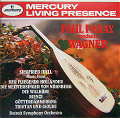 One would expect Paray, a quintessential French conductor, to
either avoid, be indifferent to, or stumble badly over the works of the key German
composer. And yet, this is one of the very best Wagner compilations around. It begins with
a Flying Dutchman Overture that is ardent, beautifully played and shorn of
interpretive rhetoric. The Meistersinger Suite is not the standard overture, but a
combination of the wistful Act III Prelude, the playful dance of the apprentices,
and then the monumentally powerful music in praise of the master-singers which concludes
the overture (and, ultimately, the opera); this progression makes perfect sense, both
musically and dramatically, depicting the melancholy of age worrying over the future,
alleviated by faith in the children in whose hands the future will lie, and sealed by a
statement of decisive leadership of the current generation. The otherwise well-conceived
program concludes on a bizarre note (literally) – the final selection is the Prelude
to Act III (not the more common Prelude to Act I) of Tristan, which
wallows in grief and then simply cuts off a plaintive and poignant solo oboe passage;
it’s deeply moving, but a rather bizarre choice and a musical downer. Reprogramming
the last two tracks, so that the Prelude leads into the lovely Siegfried Idyll,
works much better. One would expect Paray, a quintessential French conductor, to
either avoid, be indifferent to, or stumble badly over the works of the key German
composer. And yet, this is one of the very best Wagner compilations around. It begins with
a Flying Dutchman Overture that is ardent, beautifully played and shorn of
interpretive rhetoric. The Meistersinger Suite is not the standard overture, but a
combination of the wistful Act III Prelude, the playful dance of the apprentices,
and then the monumentally powerful music in praise of the master-singers which concludes
the overture (and, ultimately, the opera); this progression makes perfect sense, both
musically and dramatically, depicting the melancholy of age worrying over the future,
alleviated by faith in the children in whose hands the future will lie, and sealed by a
statement of decisive leadership of the current generation. The otherwise well-conceived
program concludes on a bizarre note (literally) – the final selection is the Prelude
to Act III (not the more common Prelude to Act I) of Tristan, which
wallows in grief and then simply cuts off a plaintive and poignant solo oboe passage;
it’s deeply moving, but a rather bizarre choice and a musical downer. Reprogramming
the last two tracks, so that the Prelude leads into the lovely Siegfried Idyll,
works much better.
- Schumann – Symphony # 1 in B-flat ("Spring") (3/1958); Symphony
# 2 in C (12/1955); Symphony # 3 in E-flat ("Rhenish") (11/1956); Symphony
# 4 in d (12/1954 – monaural); Manfred Overture (3/1958). 289 462 955-2 (2
CDs) (1999).
This volume presents a unique opportunity – Paray’s only set of the integral
symphonies of a single composer. His only foray into German music beyond the Wagner
excerpts noted above is equally credible. While the proliferation of original instrument
renditions have changed our perception of these works over the past decade, Paray’s
readings are traditional. Even so, they sound quite modern, as they solve the
"problem" of Schumann’s heavy textures with brisk rhythms, lyricism and
energy, while duly respecting the composer’s fundamental seriousness. Rather than
apply a consistent style, Paray finds the appropriate approach to each work, ranging from
an incredibly airy and propulsive Overture to a suitably fiery and dramatic Symphony
# 2. An added bonus is the Symphony # 4 in rich but detailed mono. It’s
the earliest of the Paray/DSO records on CD and tantalizingly suggests the excellence of
the others. Hopefully they’ll soon appear, although it’s likely that this one
was included only to complete this set. With the acclaimed recent release of several early
‘fifties Kubelik/Chicago CDs, perhaps Mercury has overcome its fear of mono and will
now proceed to reissue the rest of the Paray/DSOs. His only foray into German music beyond the Wagner
excerpts noted above is equally credible. While the proliferation of original instrument
renditions have changed our perception of these works over the past decade, Paray’s
readings are traditional. Even so, they sound quite modern, as they solve the
"problem" of Schumann’s heavy textures with brisk rhythms, lyricism and
energy, while duly respecting the composer’s fundamental seriousness. Rather than
apply a consistent style, Paray finds the appropriate approach to each work, ranging from
an incredibly airy and propulsive Overture to a suitably fiery and dramatic Symphony
# 2. An added bonus is the Symphony # 4 in rich but detailed mono. It’s
the earliest of the Paray/DSO records on CD and tantalizingly suggests the excellence of
the others. Hopefully they’ll soon appear, although it’s likely that this one
was included only to complete this set. With the acclaimed recent release of several early
‘fifties Kubelik/Chicago CDs, perhaps Mercury has overcome its fear of mono and will
now proceed to reissue the rest of the Paray/DSOs.
- Mendelssohn – A Midsummer’s Night Dream, Incidental Music
(3/1958); Symphony # 5 in d ("Reformation") (3/1958). Haydn –
Symphony # 96 in D (10/1956). 289 434 396-2 (1998).
Among German composers, Mendelssohn’s light and graceful compositions approach the
French aesthetic more closely than any others.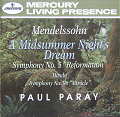 Paray’s Midsummer’s Night
Dream is exquisite. The scherzo, in particular, with its astounding ensemble and
precise articulation of notes and accents, is a testament to the excellence of the
DSO’s musicianship. He presents the austere "Reformation" Symphony
in a kaleidoscope of moods – the opening is tempestuous, the scherzo graceful and
elegant, the hymn surprisingly light and sweet, and the closing bouncy and affirmative.
The Haydn is bigger-boned than we are now accustomed, but vital and detailed. Paray’s Midsummer’s Night
Dream is exquisite. The scherzo, in particular, with its astounding ensemble and
precise articulation of notes and accents, is a testament to the excellence of the
DSO’s musicianship. He presents the austere "Reformation" Symphony
in a kaleidoscope of moods – the opening is tempestuous, the scherzo graceful and
elegant, the hymn surprisingly light and sweet, and the closing bouncy and affirmative.
The Haydn is bigger-boned than we are now accustomed, but vital and detailed.
- Dvorak – Symphony # 9 in e ("From the New World")
(2/1960). Sibelius – Symphony # 2 in D (1/1959). 434 317-2 (1992).
Here are two more readings that defy expectations. Dvorak’s innate charm and
lyricism would seem a natural fit for Paray, but the power of this performance is derived
not from any special interpretive insight but rather from the extraordinary precision and
polish of the playing. Perhaps Paray felt a special devotion to this work and sought to
express some of his own feelings as a guest in the New World, much as Dvorak had done in
composing it 70 years earlier. Even more surprising, though, is Paray’s fully
dramatic Sibelius, complete with striking tempo changes, strong accents and extreme
dynamic contrasts, which derives even more power from the magnificent execution and
recording quality. Perhaps it all goes to show the futility of trying to reduce a great
artist to a monochromatic stereotype. but the power of this performance is derived
not from any special interpretive insight but rather from the extraordinary precision and
polish of the playing. Perhaps Paray felt a special devotion to this work and sought to
express some of his own feelings as a guest in the New World, much as Dvorak had done in
composing it 70 years earlier. Even more surprising, though, is Paray’s fully
dramatic Sibelius, complete with striking tempo changes, strong accents and extreme
dynamic contrasts, which derives even more power from the magnificent execution and
recording quality. Perhaps it all goes to show the futility of trying to reduce a great
artist to a monochromatic stereotype.
- Rachmaninov – Symphony # 2 in e (3/1957). Franck – Symphony
in d (11/1959). 434 368-2 (1996)
For his only stereo foray into Russian music, Paray resists the considerable temptation
to underline the score’s feverish emotion and lets the natural beauty of
Rachmaninov’s ravishing lyricism speak for itself.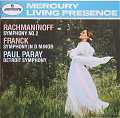 True, the performance is cut and
swift, but perhaps that’s the best way to make a convincing case for a work that
boasts some of the most gorgeous melodies that ever graced a symphony but does tend to
meander. Only in the third movement does Paray’s approach seem a bit perfunctory. The
sound quality deteriorates at the conclusion (and now can’t be blamed on inner-groove
distortion). In the Franck, Paray steers a middle course, downplaying mysticism to dwell
on the lyricism and inherent drama to permit the work to flow its course – quite
appropriate in a tightly-structured symphony in which common themes (derived from a single
motif) unite all 3 movements and in which the second cleverly blends elements of the
traditionally separate adagio and scherzo. The orchestral balance and bright recording
favor blazing brass. At 80 minutes, this disc is an especially fine value. True, the performance is cut and
swift, but perhaps that’s the best way to make a convincing case for a work that
boasts some of the most gorgeous melodies that ever graced a symphony but does tend to
meander. Only in the third movement does Paray’s approach seem a bit perfunctory. The
sound quality deteriorates at the conclusion (and now can’t be blamed on inner-groove
distortion). In the Franck, Paray steers a middle course, downplaying mysticism to dwell
on the lyricism and inherent drama to permit the work to flow its course – quite
appropriate in a tightly-structured symphony in which common themes (derived from a single
motif) unite all 3 movements and in which the second cleverly blends elements of the
traditionally separate adagio and scherzo. The orchestral balance and bright recording
favor blazing brass. At 80 minutes, this disc is an especially fine value.
- Suppe – Overtures: The Beautiful Galatea, Pique Dame, Light Calvary,
Poet and Peasant, Morning, Noon and Night, Boccaccio (all 11/1959). Auber
– Overtures: The Bronze Horse, Fra Diavolo, Masaniello (all 4/1959). 434 309-2
(1992).
These works are quintessentially Viennese and speak the same language as Johann Strauss
– rhythmically vital, vivacious, infectious.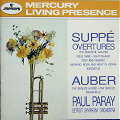 Both composers spent their lives in
the lyric theatre and produced instantly accessible music without a shred of pretense.
Like Toscanini, Paray appeared to take special pride in according light classical fluff
the attention and respect usually reserved for more substantial challenging music with
polished and convincing readings. Many prominent conductors (including, I’m sorry to
say, Bernstein) have discouraged appreciation and enjoyment of these and similar works
with sloppy throwaway runthroughs; here, though, they’re carefully prepared and
magnificently played with a delightful combination of care and zest. Both composers spent their lives in
the lyric theatre and produced instantly accessible music without a shred of pretense.
Like Toscanini, Paray appeared to take special pride in according light classical fluff
the attention and respect usually reserved for more substantial challenging music with
polished and convincing readings. Many prominent conductors (including, I’m sorry to
say, Bernstein) have discouraged appreciation and enjoyment of these and similar works
with sloppy throwaway runthroughs; here, though, they’re carefully prepared and
magnificently played with a delightful combination of care and zest.
- Bizet – La Patrie Overture (3/1958); Carmen Suite (11/1956); L’Arlesienne
Suites 1 and 2 (11/1956). Thomas – Mignon Overture; Raymond Overture
(11/1960). 434 321-2 (1992).
At last we turn to the French music in which his fame arose. Paray and the DSO give
suitably spirited readings of the Bizet and Thomas overtures. While the Arlesienne pieces
are somewhat understated (and the Carillon, Pastorale and Farandole sections are
considerably more deliberate than is the custom), they’re colorful and nicely
characterized. Note, though, that the Carmen Suite is Paray’s own selection
which avoids orchestration of vocal parts and therefore sticks entirely to the preludes
(and the first act change of the guard, where the orchestra doubles the vocal lines anyway
to reinforce a sometimes-shaky children’s chorus) and omits many of the usual items.
It does, however, include a cough at Track 3, 1:01, perhaps suggesting that these tapings
were more akin to an actual performance than a product of the splicing block (and thus
creating even more admiration for their formal perfection). While the Arlesienne pieces
are somewhat understated (and the Carillon, Pastorale and Farandole sections are
considerably more deliberate than is the custom), they’re colorful and nicely
characterized. Note, though, that the Carmen Suite is Paray’s own selection
which avoids orchestration of vocal parts and therefore sticks entirely to the preludes
(and the first act change of the guard, where the orchestra doubles the vocal lines anyway
to reinforce a sometimes-shaky children’s chorus) and omits many of the usual items.
It does, however, include a cough at Track 3, 1:01, perhaps suggesting that these tapings
were more akin to an actual performance than a product of the splicing block (and thus
creating even more admiration for their formal perfection).
- Chabrier – Espana, Suite pastorale, Fete polonaise, Gwendoline Overture,
Danse slave (all 11/1960); Marche joyeuse (9/19159); Bourree fantasque
(3/1957). Roussel – Suite in f (3/1957). 434 303-2 (1991).
As aptly noted in the fine liner notes by David Rubin, Chabrier’s art is
characterized by its fresh and spontaneous exhuberance,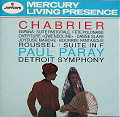 all the more remarkable bacause it
arose not in a spate of sudden inspiration but rather through meticulous craftsmanship and
constant revision.. More remarkable still is that Chabrier began composing only in his
‘forties and succumbed to mental illness shortly thereafter. The splendor of this
record perhaps derives its inspiration from the composer – meticulous rehearsal to
achieve precision and grace in a context of impulsive joy that beautifully recreates and
realizes Chabrier’s essence. all the more remarkable bacause it
arose not in a spate of sudden inspiration but rather through meticulous craftsmanship and
constant revision.. More remarkable still is that Chabrier began composing only in his
‘forties and succumbed to mental illness shortly thereafter. The splendor of this
record perhaps derives its inspiration from the composer – meticulous rehearsal to
achieve precision and grace in a context of impulsive joy that beautifully recreates and
realizes Chabrier’s essence.
- Chausson – Symphony in B-flat (3/1956). Lalo – Le Roi
d’Ys, Overture (3/1959); Namouna, Suite # 1 (3/1958). Barraud
– Offrande a une Ombre (3/1957). 434 389-2 (1997).
This is one of the very few Paray records that strikes me as less than fully successful
– he struggles to find Gallic grace and charm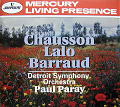 in a work that has very little and
which sounds more convincing in the more pointed, energetic and overtly dramatic readings
of his French contemporaries Munch and Monteux. The recording, too, is blurred and
substandard. The Barraud is an earnest but cloying little piece that depicts too literally
the loss of innocence in war (ie: a pastoral flute is submerged in martial drumming). The
Lalo overture and suite are far less pretentious and far more enjoyable. in a work that has very little and
which sounds more convincing in the more pointed, energetic and overtly dramatic readings
of his French contemporaries Munch and Monteux. The recording, too, is blurred and
substandard. The Barraud is an earnest but cloying little piece that depicts too literally
the loss of innocence in war (ie: a pastoral flute is submerged in martial drumming). The
Lalo overture and suite are far less pretentious and far more enjoyable.
- "Paul Paray Conducts Dances of Death" -- Liszt – Mephisto Waltz;
Weber – Invitation to the Dance; Saint-Saens – Danse
Macabre (all 1/1959). Strauss – Dance of the Seven Veils from
"Salome"; Schmitt –La Tragedie de Salome (both 3/1958).
434 336-2 (1994).
This collection just might have the most off-putting title of all time. It’s also
inappropriate, as one of the five selections, the Invitation to the Dance, is all
carefree froth and has nothing whatever to do with the grim reaper; in the contrary,
it’s a delightful depiction of a breezy, whirlwind dance without even a hint of
impending doom and the liner notes don’t pretend otherwise. In any event, Paray
consistently places his musical emphasis on the lyrical dance element of these pieces
rather than on the darker stuff, and generally slights the diabolic energy to which most
other conductors give equal measure and which forms much of their appeal – the Danse
Macabre sounds playful and disarming and the Strauss, with its demonic overtones,
emerges far more bright and sprightly than we are accustomed. The Schmitt is a relative
rarity in which Paray’s lyricism nicely complements the composer’s own darker
and more dramatic 1930 EMI recording. Given Paray’s interpretive bent, perhaps the
producer’s penchant for a melodramatic title would have been better served by
"Life in the Shadows of Death." is all
carefree froth and has nothing whatever to do with the grim reaper; in the contrary,
it’s a delightful depiction of a breezy, whirlwind dance without even a hint of
impending doom and the liner notes don’t pretend otherwise. In any event, Paray
consistently places his musical emphasis on the lyrical dance element of these pieces
rather than on the darker stuff, and generally slights the diabolic energy to which most
other conductors give equal measure and which forms much of their appeal – the Danse
Macabre sounds playful and disarming and the Strauss, with its demonic overtones,
emerges far more bright and sprightly than we are accustomed. The Schmitt is a relative
rarity in which Paray’s lyricism nicely complements the composer’s own darker
and more dramatic 1930 EMI recording. Given Paray’s interpretive bent, perhaps the
producer’s penchant for a melodramatic title would have been better served by
"Life in the Shadows of Death."
- "Marches and Overtures a la Francaise" -- Meyerbeer – Coronation
March. Gounod – Funeral March of a Marionette. Saint-Saens
– Marche Militaire francaise; Marche heroique. De Lisle – La
Marseillaise (all 4/1959). Adam – If I Were King Overture. Boieldieu
– La Dame blanche Overture (both 11/1960). Offenbach – La belle
Helene; Orpheus in the Underworld; The Tales of Hoffman, Suite (all 4/1959). Rossini
– William Tell Overture (1/1959). 434 332-2 (1993).
- "French Opera Highlights" -- Herold – Zampa Overture
(1/1960). Auber – The Crown Diamonds Overture (1/1960). Gounod –
Ballet Music from "Faust". Saint-Saens – Bacchanale from
"Samson and Delilah." Berlioz – Royal Hunt and Storm from
"The Trojans." Massanet – Overture to "Phedre."
Thomas – Gavotte from "Mignon (all 3/1962). Bizet – Danse
Boheme from "Carmen" (3/1961). 432-014-2 (1991).
I’ve grouped these together simply because they’re both miscellaneous
hodge-podges, from the trite (the Marseillaise), to the obscure (the Gounod Funeral
March, better known as the theme from "Alfred Hitchcock Presents") to the
out of place (what’s the Italian Rossini’s overture to an Italian opera whose
action is set in Switzerland doing in a collection of French stuff?). Despite varying
inspiration, all is played with precision, grace and authority. A special tribute to the
natural recording quality – the gracious triangle in several pieces is a barely
audible garnish, rather than the fire-alarm exaggeration in nearly every other multi-miked
hi-fi extravaganza version. better known as the theme from "Alfred Hitchcock Presents") to the
out of place (what’s the Italian Rossini’s overture to an Italian opera whose
action is set in Switzerland doing in a collection of French stuff?). Despite varying
inspiration, all is played with precision, grace and authority. A special tribute to the
natural recording quality – the gracious triangle in several pieces is a barely
audible garnish, rather than the fire-alarm exaggeration in nearly every other multi-miked
hi-fi extravaganza version.
- Berlioz – Symphonie Fantastique (11/1959); Hungarian March
(4/1959); Trojan March (4/1959); The Corsaire, Overture (3/1958); The
Roman Carnival, Overture (3/1958). 434 328-2 (1993).
This is a fast and propulsive reading (45 minutes), which properly emphasizes the
composer’s youthful, romantic obsession that generated the work. Paray plays
particular attention to the interplay of instrumental colors long before this approach
became de rigeur by the Norrington and Gardiner original-instrument recordings. He
also creates strong rhythmic emphases, going so far as to accent every beat in the opening
of the second Ball movement. The marches are beautifully played, if a bit staid,
while the overtures are colorful, bright, and ardent. Paray plays
particular attention to the interplay of instrumental colors long before this approach
became de rigeur by the Norrington and Gardiner original-instrument recordings. He
also creates strong rhythmic emphases, going so far as to accent every beat in the opening
of the second Ball movement. The marches are beautifully played, if a bit staid,
while the overtures are colorful, bright, and ardent.
- Saint-Saens – Symphony # 3 in c ("Organ"), with Marcel
Dupre, organist (10/1957). Paray – Mass for the 500th
Anniversary of the Death of Joan of Arc, with Frances Yeend, soprano, Frances Bible,
mezzo-soprano; David Lloyd, tenor, Yi-Kwei-Sze, bass and the Rackham Symphony Choir
(10/1956). 432 719-2 (1991).
The "Organ" Symphony is cast in seething Teutonic mysticism and is
usually played with booming bass and surging power. Paray lightens the textures and yields
a lithe,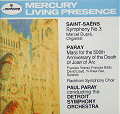 supple and pointed reading in which inner voices are far more prominent than
usual. It’s always fascinating and significant to hear a conductor’s own
compositions in which they can reveal their own aesthetic outlook even more readily than
when interpreting the instructions of others. Despite the gravity of its timeless theme,
Paray’s own Mass, written in 1931, is a deeply beautiful work – ardent,
lush and romantic, yet buoyant, refreshing and gracious. Without being blatantly
innovative, it’s original enough to not sound derivative and is a work that should be
far better known. With this example of how Paray chose to organize his own musical world,
his application of similar principles to the music of others fits into place. The CD
concludes with touching impromptu remarks Paray made to the performers upon concluding
this recording session. More striking than the words themselves is the extreme difficulty
with which he tried to express his thoughts in English years after assuming his position
at the helm of a great American orchestra. Perhaps it only goes to show that despite
cultural nationalism, music is indeed the most universal of all languages. supple and pointed reading in which inner voices are far more prominent than
usual. It’s always fascinating and significant to hear a conductor’s own
compositions in which they can reveal their own aesthetic outlook even more readily than
when interpreting the instructions of others. Despite the gravity of its timeless theme,
Paray’s own Mass, written in 1931, is a deeply beautiful work – ardent,
lush and romantic, yet buoyant, refreshing and gracious. Without being blatantly
innovative, it’s original enough to not sound derivative and is a work that should be
far better known. With this example of how Paray chose to organize his own musical world,
his application of similar principles to the music of others fits into place. The CD
concludes with touching impromptu remarks Paray made to the performers upon concluding
this recording session. More striking than the words themselves is the extreme difficulty
with which he tried to express his thoughts in English years after assuming his position
at the helm of a great American orchestra. Perhaps it only goes to show that despite
cultural nationalism, music is indeed the most universal of all languages.
- Debussy – Iberia; La Mer; Prelude a l’apres-midi d’un faune
(all 12/1955). Ravel – Ma Mere l’Oye (3/1957). 434 343-2 (1994).
- Debussy – Nocturnes for Orchestra (3/1961); Petite Suite
(4/1959). Ravel – Daphnis et Chloe Suite # 2 (3/1961); Valses Nobles
et Sentimentales (4/1959); Bolero (3/1958). 434 306-2 (1992).
- Ravel – Rhapsodie Espagnole; alborada del Gracioso; Pavane pur une
Infante defunte; La Valse. Ibert – Escales (all 3/1962). Ravel
– Le Tombeau de Couperin (4/1959). 432 003-2 (1990).
When all is said and done, it comes down to this – one of the world’s
greatest French conductors and one of the world’s   finest French orchestras playing
the very essence of French music. All of these readings are fine but my favorite, and
indeed my favorite of all of the Paray/DSO performances, is the final Rigaudon of
Ravel’s Tombeau de Couperin, which for me crystallizes the brilliance of the
artists and of this entire series. The conductor and "his" orchestra transform
Ravel’s gracious and respectful tribute to his cultural forbear into an ecstatic
shout of joy. Played deliriously fast yet with breathtaking precision, this is a pure
celebration of the apex of French culture – graceful yet powerful; complex yet
elegant; understated yet deeply emotional; committed yet relaxed; respectful of tradition
yet thoroughly modern; each instrument gleaming with individual pride yet perfectly
nestled in the ensemble; utterly natural yet exquisitely polished; deeply cultured yet an
invitation for all to enjoy and partake of its wonder. It’s a stunning tribute to
these and so many other things. finest French orchestras playing
the very essence of French music. All of these readings are fine but my favorite, and
indeed my favorite of all of the Paray/DSO performances, is the final Rigaudon of
Ravel’s Tombeau de Couperin, which for me crystallizes the brilliance of the
artists and of this entire series. The conductor and "his" orchestra transform
Ravel’s gracious and respectful tribute to his cultural forbear into an ecstatic
shout of joy. Played deliriously fast yet with breathtaking precision, this is a pure
celebration of the apex of French culture – graceful yet powerful; complex yet
elegant; understated yet deeply emotional; committed yet relaxed; respectful of tradition
yet thoroughly modern; each instrument gleaming with individual pride yet perfectly
nestled in the ensemble; utterly natural yet exquisitely polished; deeply cultured yet an
invitation for all to enjoy and partake of its wonder. It’s a stunning tribute to
these and so many other things.
Perhaps what we really have here, and throughout this entire series, is the sonic trace
of a deeply human story. Paray’s extraordinary efforts to transform the Detroit
Symphony into the world’s greatest French orchestra created a preserve for a dying
tradition of which he was a final ambassador in an astoundingly unlikely place as
geographically and culturally distant from its source as possible. These records testify
to his success in meeting that daunting challenge, and deserve to be a proud and permanent
part of not only the French cultural tradition but ours and everyone else’s as well.
Unfortunately, except for the Schumann Symphonies, none of Paray's mono recordings seems apt to be issued in the Mercury series. However, Paray fans do have one other resource – among the offerings of the Classical Recordings Archive of America are dozens of Paray concert CDs, including his last three full Detroit Symphony seasons, recorded by the musicians union and featuring repertoire from Bach to Mahler that he never taped in the studio. There's no website, but owner Nathan Brown can be reached at nateincottonwood2@webtv.net

Copyright 1999 by Peter Gutmann
|